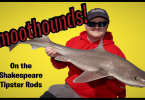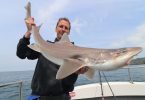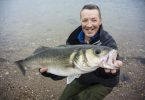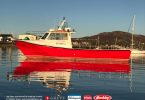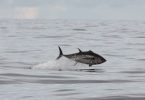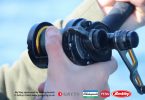Boat angling is my thing. It’s my speciality and the basis of my career, but like many sea anglers I first got into saltwater angling fishing from the shore, dangling a line from a pier. To this day I still find shore fishing just as exciting as I did then, but due to my busy boat fishing life, my shore fishing trips these days are usually about an afternoon’s fun with my kids. There are many different types of shore angling, each with its own charms and challenges. Here’s a brief look at what UK saltwater shore fishing has on offer…
Pier Fishing
Piers and breakwaters offer easy access and simple fishing. They are often the first choice for novice anglers, for those wanting an easy afternoon’s fishing and obviously they make a great venue for disabled and elderly anglers. Find a pier anywhere in the UK and there will usually be a few fish around it somewhere.
 Piers offer a free home for many species of sea fish and also a place in which to feed. Bait-fish often seek shelter around piers because the structure from which piers are made attracts plant growth and shellfish, which are the start of the food chain. Piers also form an obstruction in the tide and this is another feature which attracts fish too. Imagine them as a shelter in a barren and windy desert. Most piers will attract both surface/mid-water and bottom feeding fish species like Bass, Mackerel, Garfish, Mullet, Wrasse, Dogfish and Black Bream.
Piers offer a free home for many species of sea fish and also a place in which to feed. Bait-fish often seek shelter around piers because the structure from which piers are made attracts plant growth and shellfish, which are the start of the food chain. Piers also form an obstruction in the tide and this is another feature which attracts fish too. Imagine them as a shelter in a barren and windy desert. Most piers will attract both surface/mid-water and bottom feeding fish species like Bass, Mackerel, Garfish, Mullet, Wrasse, Dogfish and Black Bream.
For the new sea angler, piers offer social angling where many anglers will be fishing in close proximity to one another and it is for this reason that they are great for a novice as they get to learn from the angler next to them. Some of the simplest and most fun pier fishing can be found over the summer months, although autumn and winter are often regarded by more seasoned anglers as prime months to target big species like Conger and Cod.
General Pier fishing rods are usually 9-10ft in length so they are not cumbersome when they are used in close proximity to other anglers. Most pier rods are built for use with fixed spool reels and they are suitable for both float and light bottom fishing techniques. For targeting bigger species from piers, Beach and Rock fishing rods are normally used.
Beach Casting
For lots shore anglers, beach fishing is quite often the next rung up the ladder from pier fishing because it requires a higher level of rig making and bait presentation skills. Beaches also make good, safe competition venues where many anglers can be spread out in fair competition against one another.
Beach fishing, or “Beach Casting” as it is known, allows the angler to get away from the hustle and bustle of pier fishing. Some beaches can be found on the sea fronts of large towns while others can be located in small, secret coves, tucked away further along the coast away from any town. Beaches offer challenging fishing and more often than not, this will be for bottom-feeding species like Codling, Whiting, Bass, Dogfish, Flatfish and Rays.
Different species will be available from different beaches, and each beach will have its own particular methods and baits. Some beaches will also offer excellent lure fishing for Bass, especially in southern half of the UK during summer and autumn. Bassing and bass/spinning rods, is/are something I plan to look at in more detail at a later date.
General beach fishing rods (beach casters) are usually 12-14ft in length and are rated by how much lead is required to load the rod for casting (for example 4-8oz). All beach casting rods have a super sensitive tip for bite detection, and are solely designed for bottom fishing. Unlike Pier fishing rods, beach casters often come in both fixed spool and multiplier reel versions.
 Rock Fishing
Rock Fishing
Rock fishing is for the shore angler who is looking for the extreme – the wild and rugged coast! Lots of sea anglers progress onto rock fishing because, for the shore angler, it often offers the greatest chance of big fish. This rocky and rugged environment clearly has its own natural charm too! Good rock fishing can be found from most UK coastlines.
Most rock fishing venues can offer fishing for many different species because the terrain under the water can be just as varied as the shoreline above it. Some rock fishing marks offer deepwater; others offer shallow water; some will offer fishing over reefs; whilst some will offer fishing over sand. Rock marks can attract surface, mid-water and bottom feeding fish species including Mackerel. Garfish, Pollack, Bass, Conger, Bull Huss and Ballan Wrasse to name but a few!
Rock fishing rods are similar to beach fishing rods in that they are usually 12-14ft in length, however rock fishing rods are more heavily constructed, to cope with the environment and fish species they are likely to be up against – the force that may need to be put on a rock fishing rod to stop fish running and snagging up in rocky holes means that these rods need strength to take the strain. Almost all rock fishing rods are made for bottom fishing using multiplier reels.
A word of warning comes with Rock-fishing! Very few anglers get into danger on a pier and again very few anglers get into trouble fishing from beaches, but rocks are a different story. Rock fishing marks on the open coast are exposed and can be dangerous! Always rock fish using the buddy system and let somebody else know where you are going and what time you expect to return.
 Well there you have it – three very different styles of shore fishing to take your pick from. If you’re planning on trying sea fishing for the very first time, my advice would be to hit your local pier or an easy access beach within walking distance from a busy town, then if you find you like shore fishing, and as you get better at it, progress onto rock fishing.
Well there you have it – three very different styles of shore fishing to take your pick from. If you’re planning on trying sea fishing for the very first time, my advice would be to hit your local pier or an easy access beach within walking distance from a busy town, then if you find you like shore fishing, and as you get better at it, progress onto rock fishing.
The pics with this episode are from a pier fishing session with my three year old Lola. Note: a pocket full of tackle, a handful of bait, and a whole bundle of fun fishing for Mackerel and small Pollack! For the newcomer to shore fishing, pier fishing is very simple, and is usually very productive.
Next time, we’ll take a brief look at UK saltwater boat fishing.
Jim
Name Jim O’Donnell
Angling guide, fishing journo, writer & photographer
Website www.jim-odonnell.co.uk (currently under reconstruction)
Blog http://www.worldseafishing.com/blogsdiaries/jimodonnell/
Catch up with Jim on Facebook www.facebook.com/saltandslime
To find out more about Jim’s Florida Keys fishing holidays check out www.fishinginflorida.co.uk

Jim & Lola spending some quality time together













